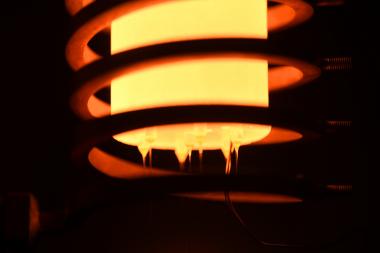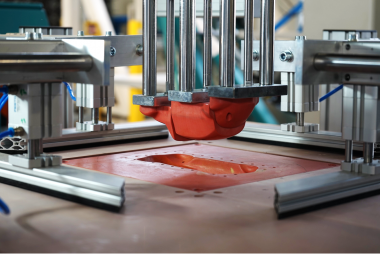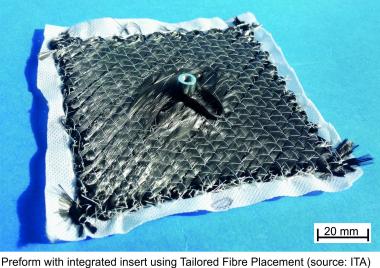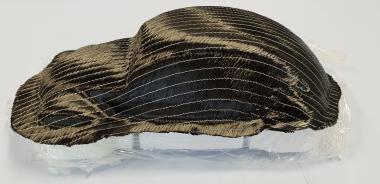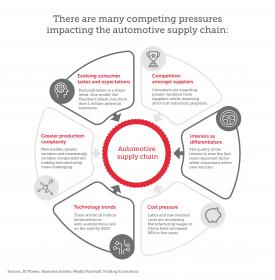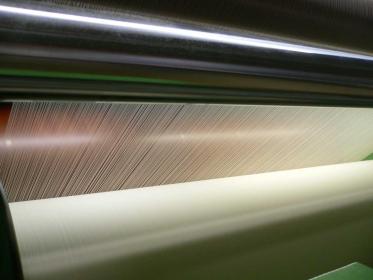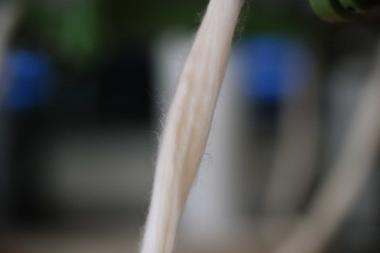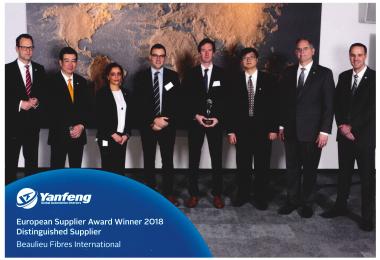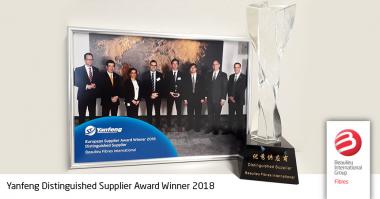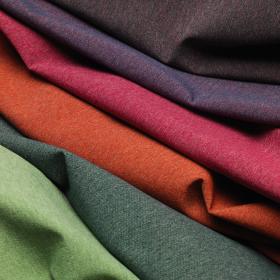Hexcel at JEC World 2019
- Hexcel’s Composite Innovations For Aerospace, Automotive, Energy And Marine Applications At JEC World 2019 Hall 5 - Stand J41
STAMFORD, Conn. – At this year’s JEC World taking place in Paris on March 12-14, Hexcel will promote a wide range of composite innovations for customer applications in aerospace, automotive, energy and marine markets.
Aerospace Innovations
Hexcel’s HiTape® and HiMax™ dry carbon reinforcements were developed to complement a new generation of HiFlow™ resin systems, producing high quality aerospace structures using the resin infusion process. HiTape® was developed for the automated lay-up of preforms and HiMax™ is a range of optimized non-crimp fabrics (NCF). Both products incorporate a toughening veil to enhance mechanical properties, meeting the structural requirements for aerospace parts.
Visitors to JEC will see an Integrated Wing Panel demonstrator and an I-beam, both made with HiTape® reinforcements, and an Opticoms rib made with HiMax™ NCF. The Opticoms rib and I Beam were both manufactured using C-RTM (Compression Resin Transfer Molding). They were injected with Hexcel’s RTM6 resin in a process taking less than 5 minutes. The total manufacturing cycle for both parts was just 4.5 hours.
Also among the Aerospace exhibits, Hexcel will display a composite petal for a satellite antenna, manufactured by Thales Alenia Space Italia. The petal is part of a set of 24 deployable structural elements that form the large area reflector assembly used on board Low Earth Orbit (LEO) observation satellites. Thales Alenia Space Italia selected Hexcel’s HexPly® M18 prepreg for this application, acknowledging the superior mechanical and outgassing properties provided.
Another Hexcel prepreg application on show is a “zero” frame, manufactured by Aerofonctions for the engine area of Daher’s TBM 910/930 single-engine turboprop aircraft. Hexcel’s HexPly® M56 prepreg was selected by Daher for the “zero” frame – a product developed for Out of Autoclave applications that provides the same high quality and performance as autoclave-cured prepregs, from a simple vacuum bag cure in an oven.
With 50 years of experience behind its comprehensive range of high-strength, high-strain PAN-based carbon fibers, Hexcel continues to innovate, and is introducing two new fibers to its portfolio. HexTow® HM50 combines high modulus and high tensile strength, making it ideal for commercial and defense aircraft and engines. HexTow® 85 was developed specifically to replace rayon-based carbon fiber for ablative applications.
HexTow® carbon fiber holds the most qualified carbon fiber positions on aerospace programs in the industry and is the best unsized fiber available on the market. It provides excellent bonding interfacial properties with thermoplastic matrices and is the best-performing fiber for 3D printing applications.
Additive manufacturing is another area of expertise for Hexcel, using PEKK ultra-high performance polymers and HexAM™ technology to manufacture carbon-reinforced 3D printed parts. This
innovative process provides a weight-saving solution for intricate parts in highly demanding aerospace, satellite and defense applications. HexPEKK™ structures offer significant weight, cost and time-to-market reductions, replacing traditional cast or machined metallic parts with a new technology.
Hexcel is well known for its range of weight-saving, stiffness-enhancing honeycombs and the company adds value by providing a range of engineered core solutions to customers from facilities in the USA, Belgium and the newly opened Casablanca plant in Morocco. Hexcel’s engineered core capabilities enable highly contoured parts with precision profiling to be produced to exacting customer specifications. An example of such a part will be on display at JEC. Made from Aluminum FlexCore®, the part is CNC machined on both sides, and formed and stabilized with both peel ply and flyaway layers of stabilization. Aircraft engines benefit from a number of Hexcel core technologies including HexShield™ honeycomb that provides high temperature resistance in aircraft engine nacelles. By inserting a thermally resistant material into honeycomb cells, Hexcel provides a core product with unique heat-shielding capabilities that allows for the potential re-use of material after a fire event.
Hexcel’s Acousti-Cap® broadband noise-reducing honeycomb significantly improves acoustic absorption in aircraft engine nacelles. The acoustic treatment may be positioned at a consistent depth and resistance within the core, or can be placed in a pattern of varying depths and/or resistances (Multi-Degrees of Freedom and 3 Degrees Of Freedom), offering an acoustic liner that is precisely tuned to the engine operating conditions. These technologies have been tested at NASA on a full engine test rig and meet all 16 design conditions without trade-offs.
HexBond™ – the new name in Adhesives
Hexcel’s range of high performance adhesives has expanded considerably following the company’s acquisition of Structil. The company has now decided to unite the range by marketing all of its adhesive products using HexBond™ branding. The comprehensive range of HexBond™ structural film adhesives, foaming adhesive films, paste adhesives, liquid shims, epoxy fillets and Chromium free liquid primers is suitable for a wide range of applications in combination with Hexcel’s prepreg and honeycomb products.
Automotive Innovations
Hexcel’s carbon prepreg patch technology provides an innovative way of locally stiffening and reinforcing metal parts, providing noise and vibration management functionality. HexPly® prepreg patches consist of unidirectional carbon fiber impregnated with a fast curing epoxy matrix that has self-adhesive properties, enabling it to bond to metal in a highly efficient one-step process. These key technology properties are demonstrated in an 18.5kg aluminum subframe (that is 50% lighter than steel equivalents), which was reinforced with 500 grams of HexPly® prepreg and tested by Saint Jean Industries. The part demonstrates a significant reduction in noise, vibration and harshness (NVH). Other benefits include lower production costs, energy savings, increased driver comfort, production flexibility and part count reduction. With this technology Hexcel is a finalist in the JEC Innovation Awards 2019 in the Automotive Applications category.
HexPly® prepreg patch technology was also applied to a hybrid side sill demonstrator developed with Volkswagen and Dresden University to address future crash test requirements, specifically for electric cars. Combining fiber-reinforced plastic (FRP) with metal, the hybrid construction allows for optimum performance including weight savings, enhanced safety, increased energy absorption, battery protection in a crash situation and production flexibility.
Hexcel will also display a lightweight CFRP transmission crossmember produced from Hexcel’s high performance HexMC®-i 2000 molding compound. The transmission crossmember was developed in partnership with the Institute of Polymer Product Engineering (at Linz University), Engel and Alpex. As the part connects the chassis together and supports transmission it has to be stiff and strong, resisting fatigue and corrosion. Hexcel’s HexMC®-i 2000 was selected as the best-performing molding compound on the market, curing in as little as two minutes to produce lightweight, strong and stiff parts.
To produce the transmission crossmember HexMC®-i 2000 preforms are laid up in Alpex molds and compression-molded in a v-duo press that was tailored for the application by Engel. Ribs, aluminum inserts and other functions can be molded into the part using the single-stage process, reducing component-count. Any offcuts from the preforms can be interleaved between the plies of material to provide additional reinforcement in key areas - meaning that the process generates no waste.
Other Automotive promotions on Hexcel’s stand at JEC World include a composite leaf spring manufactured by ZF using HexPly® M901 prepreg. In contrast to steel leaf springs, composite versions offer many advantages including weight savings of up to 70%, high corrosion resistance, optimized system integration and superior performance. HexPly® M901 prepreg reduces the cure cycle to below 15 minutes and provides 15% higher mechanical performance, with enhanced fatigue properties. It also operates at high temperatures, providing a Tg of up to 200°C following a post cure.
Marine Innovations
Hexcel has a comprehensive range of products aimed at racing yacht and luxury boat builders that include America’s Cup, IMOCA class and DNV GL-approved prepregs, woven reinforcements and multiaxial fabrics for hull and deck structures, masts and appendages.
At JEC World Hexcel will display an IMOCA yacht mast manufactured by Lorima using HexPly® high modulus and high strength carbon fiber prepreg from Hexcel Vert-Le-Petit. Lorima is the exclusive official supplier of masts for IMOCA 60 class racing boats.
Hexcel’s HexTow® IM8 carbon fiber has been selected as the highest performing industrial carbon fiber on the market and will be used by spar and rigging manufacturer Future Fibres to manufacture their AEROrazr solid carbon rigging for all the teams in the 36th America’s Cup.
Hexcel’s HiMax™ DPA (Dot Pattern Adhesive) reinforcements are non-crimp fabrics supplied pre-tacked, allowing multiple fabrics to be laid-up more easily in preparation for resin infusion. Providing an optimal, consistent level of adhesion, they allow a faster and more consistent resin flow, as well as eliminating the use of spray adhesive for a healthier working environment and lower risk of contamination. Simply unrolled and applied to the mold or core layer before the introduction of resin, HiMax™ DPA fabrics are widely used in boat building, where lay-up times can be reduced by up to 50%.
Wind Energy Innovations
Hexcel has developed a range of HexPly® surface finishing prepregs and semi-pregs for wind turbine blades and marine applications. Providing a tough, durable and ready-to-paint surface without using in-mold coats, these products shorten the manufacturing cycle and reduce material costs. HexPly® XF2(P) prepreg is optimized for wind blades and has a ready-to-paint surface, straight from the mold, saving at least 2 hours of takt time.
Polyspeed® pultruded carbon laminates were developed for load-carrying elements in a blade structure and are manufactured with a polyurethane matrix that provides outstanding mechanical performance in terms of stiffness and durability. The blade manufacturing process is optimized, with increased throughput. The pultruded laminates are supplied in coils as continuous cross section profiles.
HiMax™ non-crimp fabrics using E-glass, high modulus glass and carbon fibers are also available in a wide range of unidirectional, biaxial and triaxial constructions. HiMax™ fabrics have applications throughout the turbine, from the stitched carbon fiber UDs used in the main structural elements, to glass fabrics and hybrids for blade shells and nacelles. There are also specialist applications such as lightweight fabrics for heated leading edge de-icing zones.
AGENCE APOCOPE






